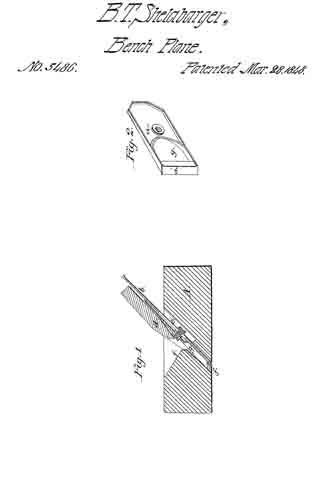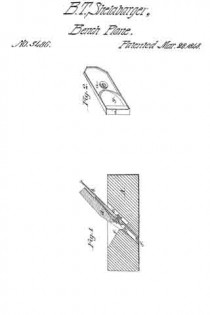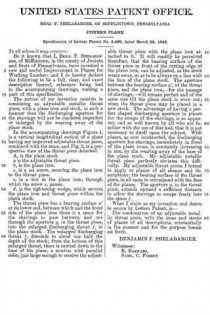No. 5,620 – Joiner’s Plane (William A. Cole) (1848)

UNITED STATES PATENT OFFICE.
_________________
WILLIAM A. COLE, OF NEW YORK, N. Y.
JOINER’S PLANE.
_________________
Specification of Letters Patent No. 13,957, dated December 18, 1855.
_________________
To all whom it may concern:
Be it known that I, WILLIAM A. COLE, of New York, in the county of New York and State of New York, have invented a new and Improved Plane for Planing Curve or Level Surfaces; and I do hereby declare the following to be a full, clear, and exact description of the same, reference being had to the annexed drawings, making a part of this specification, in which —
Figure 1 is a side elevation of the plane. Fig. 2 is an end view.
Similar letters refer to similar parts, in both figures.
The nature of my invention, consists in an improvement in the construction of the plane, by which I am enabled to curve the face of the plane either concave or convex, and regulate the face of the said plane so as to plane various curves with the same plane.
In making my improvements I take an ordinary plane, with the plane irons, &c., as usual, I then cut a convex face upon it as seen at (a–b). To the face thus prepared I attach a plate of metal (c), at the center, the length and width of the plane; at the center there is a slot cut across through which the edge of the cutting iron may pass. At each end of the plate (c) there is a slide (d) connected, which passes up against the front and back of the plane, beneath a plate of brass, space being left sufficient to allow it to pass up and down.
In operating this plane, the face plate (c) is set to the desired curve, by pushing the pieces (d) down, these are then confined in their places, by a screw (e) upon the ends of the plane as represented. It will be seen that concave and convex surfaces can be planed by this instrument, and that it can be adjusted to any desired curve, as set forth and described above.
What I claim as my invention and improvement, and desire to secure by Letters Patent, is —
The adjustable metallic spring plate, secured to the face of the plane for the purpose of planing with one plane, various curves either concave or convex, substantially as herein described and set forth.
WM. A. COLE.
Witnesses:
A. W. KELLOGG,
I. P. PIRSSON.





